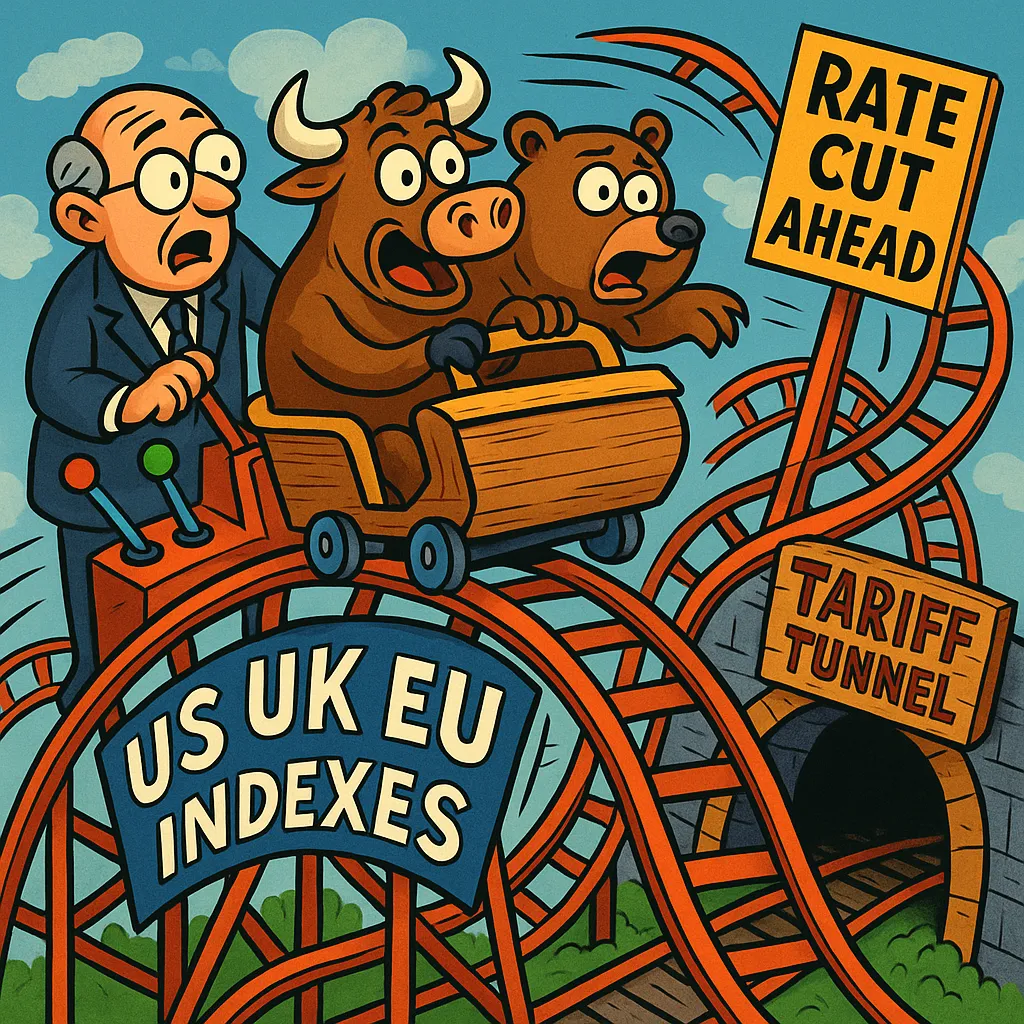Equity Markets Week Ahead (US, UK, Europe)
Traders on the floor of the New York Stock Exchange. Global equities enter the week cautiously optimistic yet still constrained by the overhang of trade tensions. The MSCI All-World stock index barely budged on Friday as investors balanced tariff fears against hopes of a negotiated truce. President Trump’s aggressive tariff regime has undoubtedly left its mark on equities: the U.S. benchmark S&P 500 is down ~3.7% year-to-date, as markets price in potential economic damage from the trade war. In contrast, defensive sectors like consumer staples and utilities – relatively insulated from economic swings – have rallied +5% or more in 2025. This leadership shift underscores investors’ protective stance. The big question for the coming week: Will incoming data and trade developments prompt a rotation back into cyclicals, or deepen the defensive posture?
Key Earnings and Macro Drivers – US: In the U.S., a busy earnings calendar could sway sentiment. All eyes are on retail giant Walmart (May 15), which will provide a read on the American consumer’s health. Analysts expect Walmart’s revenue growth to slow to ~4% this year due to tariffs, as cost pressures and potentially softer consumer demand weigh on its outlook. Any commentary on pricing (higher import costs) or consumer behavior will be scrutinized as a proxy for broader retail and inflation trends. Tech and industrial earnings continue as well – Cisco Systems (reporting May 14) will be one to watch for enterprise spending trends, and any mention of supply chain adjustments in a tariff environment.
On the data front, the U.S. will release April CPI and PPI – with inflation expected tame (headline CPI ~2.3% y/y) – and retail sales for April. A benign inflation reading, following last week’s report of steady unemployment at 4.2% and a cooler 177K payrolls gain, could bolster equities by reinforcing the Federal Reserve’s patient stance. Indeed, the Fed held rates steady at 4.25–4.50% in its May meeting, marking a third straight pause as officials assess rising uncertainties. Several Fed speakers are on tap this week (Fed Governors and regional presidents) – their remarks will be parsed for any shift in tone. Thus far, the Fed has signaled it stands ready to adjust policy if risks materialize, which markets interpret as openness to easing should the trade war dent growth. This “Fed put” has lent some support to U.S. equities, even as earnings growth slows. Investors will also keep an eye on the U.S.-China talks outcome early in the week: a breakthrough (even a partial deal or pause in new tariffs) could trigger a risk-on rally, favoring tech, industrials, and multinational stocks. Conversely, a breakdown in negotiations would likely send export-oriented stocks and the broader indices lower, at least initially, as renewed tariff escalation fears set in.
Europe and UK – Policy Support vs Trade Risks: European equity markets have been comparatively resilient, with the pan-European STOXX 600 and major indexes like Germany’s DAX and France’s CAC near recent highs. The Euro STOXX 50 ended last week with a modest gain and is roughly flat for the week amid the trade talk drama. European investors face a mix of tailwinds and headwinds: On one hand, the European Central Bank’s easing campaign is well underway – the ECB cut rates in April and is poised to do so again by June, bringing the deposit rate down to ~1.75%. This accommodative policy (eight rate cuts in 13 months) provides a cushion for equities, keeping borrowing costs low and liquidity ample. It’s helped support sectors like utilities, telecoms, and real estate across Europe. Even so, Europe’s economy – especially Germany’s manufacturing sector – is highly sensitive to global trade volumes. Developments in the trade war remain the wild card. The White House’s tariffs aren’t just aimed at China; Europe could be in the crossfire as well, with U.S. threats previously lobbed at EU auto exports. The IMF recently downgraded global and euro-area growth forecasts on the back of U.S. tariff moves, and corporate Germany (e.g. auto and industrial exporters) has signaled caution. This week, euro-area industrial production data and the German ZEW sentiment survey will be monitored for any trade-related gloom. European earnings season is winding down, but a few notable reports from export-focused firms (perhaps in the auto supply chain) could still surface – any guidance cuts or pessimistic commentary would reinforce the need for ECB support. Overall, positioning in Europe has tilted somewhat defensive as well; investors have favored sectors oriented to domestic demand (e.g. healthcare, consumer staples) over trade-dependent sectors. However, should a U.S.-China ceasefire emerge, one might expect a rotation into Europe’s beaten-down cyclicals (like carmakers and capital goods makers), which could see a relief rally on improved global trade sentiment.
In the UK, the FTSE 100 index has been buoyant, recently touching record territory around 8,550, aided by a combination of factors. The Bank of England’s rate cut – its first since the pandemic era – is generally positive for stocks, and the split vote (5–4) with some members preferring no cut or a bigger cut suggests the BoE is not on a preset easing path. This has helped keep sterling in check (though it rose on the surprise dissent, it remains historically low), which in turn benefits the many multinational companies in the FTSE via currency translation gains. Moreover, the FTSE’s heavy weighting in commodities and energy stocks means it has been influenced by oil price movements (more on oil below). UK investors are also digesting domestic data: the UK economy has shown flickers of growth (e.g. monthly GDP for Q1 came in slightly above expectations) and inflation cooled to 2.6% – before an energy-driven bump expected in April. As long as the domestic backdrop remains stable, the BoE’s dovish tilt (cutting rates to buffer the tariff hit to growth) is supportive of UK equities. However, a note of caution: many UK firms, particularly in manufacturing and financial services, could feel second-order effects of a protracted U.S.-China conflict or any U.S.-Europe tariff friction. Thus, geopolitics will drive the FTSE as much as local factors this week. A positive turn in global trade negotiations would likely lift commodity prices and investor sentiment broadly, propelling resource and bank stocks higher. Conversely, if talks collapse and risk-off ensues, expect FTSE’s defensive names (pharma, consumer staples) to outperform while miners and oil majors could lag on growth concerns.
Market Tone and Positioning: The recent behavior of stock leadership in the U.S. is instructive. Investors have huddled in defensive plays due to the tariff storm – evidenced by outperformance of staples and utilities and underperformance of cyclicals. If “Phase One” of a U.S.-China deal or at least a tariff pause emerges, we could see those defensive winners take a backseat to a resurgence in tech, industrials, and consumer discretionary stocks. Indeed, there were signs in the past month of a tentative shift: as the market bounced off April lows, cyclicals perked up relative to defensives. This week’s events could accelerate that shift if progress is concrete. For example, U.S. semiconductor and machinery companies – highly correlated with Chinese trade – might lead a rally on any positive trade news. In Europe, autos and luxury goods (which rely heavily on Chinese consumers) would similarly benefit. On the other hand, should talks falter and tariffs remain or increase, expect a renewed flight to quality: high-dividend defensive stocks, gold (and gold miners), and possibly U.S. Treasuries/utility stocks would likely jump. Portfolio managers may then lean further into those areas until clearer signs of economic stabilization.
Lastly, it’s worth noting that equity valuations have improved slightly after recent pullbacks, and many central banks (Fed, ECB, BoE, PBoC) are in easing mode or at least dovish, which provides a valuation backstop. If upcoming economic data (U.S. retail sales, China’s financing data, Europe’s industrial output) show that global growth is holding up better than feared, that could embolden investors to put cash to work in equities again. Actionable insight: We recommend maintaining a barbell strategy in the short term – holding core defensive positions (to weather further trade uncertainty) while gradually adding select cyclical exposure on dips. In practical terms, that could mean keeping overweight positions in sectors like Healthcare and Consumer Staples (which have proven resilient), but starting to accumulate shares in quality Technology and Industrials names that were sold off earlier in the trade war. This balanced approach allows participation if a relief rally occurs, without overexposure if volatility spikes. As always, prudent risk management with stop-loss orders or protective puts is advised given the binary nature of the week’s trade news. In summary, equity bulls are looking for a green light from Washington and Beijing; until it materializes, a tempered, data-dependent stance is warranted.
Check out more Forex Trade Setups on our forex page.
Please visit our Disclaimer page.
Disclaimer
Information on these pages contains forward-looking statements that involve risks and uncertainties. Markets and instruments profiled on this page are for informational purposes only and should not in any way come across as a recommendation to buy or sell in these assets.
You should do your own thorough research or engage the services of a registered financial markets professional before making any investment decisions. TerraBullMarkets.com does not in any way guarantee that this information is free from mistakes, errors, or material misstatements. It also does not guarantee that this information is of a timely nature. Investing in Open Markets or any financial instrument involves a great deal of risk, including the loss of all or a portion of your investment, as well as emotional distress.
All risks, losses and costs associated with investing, including total loss of principal, are your responsibility. The views and opinions expressed in this article are those of the authors and do not necessarily reflect the official policy or position of TerraBullMarkets.com nor any of its advertisers. The author will not be held responsible for information that is found at the end of links posted on this page.
If not otherwise explicitly mentioned in the body of the article, at the time of writing, the author has no position in any stock mentioned in this article and no business relationship with any company mentioned. The author has not received compensation for writing this article, other than from TerraBullMarkets.com.
TerraBullMarkets.com and the author do not provide personalized recommendations. The author makes no representations as to the accuracy, completeness, or suitability of this information. TerraBullMarkets.com and the author will not be liable for any errors, omissions or any losses, injuries or damages arising from this information and its display or use. Errors and omissions excepted.
The author and TerraBullMarkets.com are not registered investment advisors and nothing in this article is intended to be investment advice.

